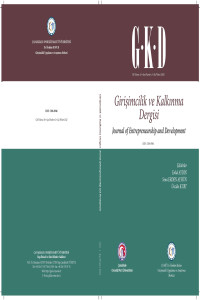Türkiye'de Sanayileşme ve Kentleşmenin Çevresel Tahribat Üzerindeki Etkisi: ARDL Sınır Testi Yaklaşımı
Öz
Bu çalışmada, Türkiye’de sanayileşme ve kentleşmenin çevresel tahribat üzerindeki etkisinin araştırılması amaçlanmaktadır. Bu doğrultuda, ilk olarak değişkenlerin durağanlığını incelemek için birim kök testi uygulanmıştır. Sonrasında, ekolojik ayakizi ve belirleyicileri arasında eş bütünleşmenin varlığını kontrol etmek için ARDL sınır testi yaklaşımı kullanılmıştır. 1961-2018 dönemine ait yıllık veriler yardımıyla gerçekleştirilen analizde, bağımlı değişken olarak; ekolojik ayakizi, bağımsız değişkenler olarak ise; sanayileşme, kentleşme ve kişi başına GSYİH kullanılmıştır. Ampirik sonuçlar incelendiğinde, uzun dönemde kentleşme ile çevresel tahribat arasında istatiksel olarak anlamlı ve pozitif yönlü bir ilişki tespit edilmiştir. Sanayileşme ile çevresel tahribat arasında istatistiksel olarak anlamlı bir ilişki tespit edilmese de, katsayıların işaretinin pozitif olması kentleşme ve sanayileşmenin çevresel tahribat üzerinde etkili olduğu sonucuna ulaştırmıştır. Ampirik bulgularımızın, Türkiye’de sürdürülebilir bir çevrenin oluşturulması açısından, ekonomik ve ekolojik politikalar için önemli etkileri vardır.
Anahtar Kelimeler
Sanayileşme Kentleşme Çevresel Tahribat ARDL Sınır Testi Yaklaşımı
Kaynakça
- AKEL, V. & GAZEL, S. (2014). “Döviz Kurları ile BİST Sanayi Endeksi Arasındaki Eşbütünleşme İlişki: Bir ARDL Sınır Testi Yaklaşımı”. Erciyes Üniversitesi İktisadi ve İdari Bilimler Fakültesi Dergisi, 0(44), 23-41.
- AL-MULALİ, U., SOLARIN, S. A., & OZTURK, I. (2016). “Investigating the presence of the environmental Kuznets curve(EKC) hypothesis in Kenya: an autoregressive distributed lag (ARDL) approach”. Natural Hazards, 80(3), 1729-1747.
- BEKHET, H. A., & OTHMAN, N. S. (2017). “Impact of urbanization growth on Malaysia CO2 emissions: Evidence from the dynamic relationship”. Journal of cleaner production, 154, 374-388.
- CAN, G., KILIÇ, C., & KURT, Ü. (2022). “Is Kuznets’ Inverted-U Hypothesıs Valid For Turkey?: ARDL BOUNDS TESTINGAPPROACH”. Yönetim Bilimleri Dergisi, 20(43), 171-190., M., ECEVİT, E., & YUCEL, A. G. (2018). “Structural breaks, urbanization and CO2 emissions: evidence from Turkey”.J Appl Econ Bus Res, 8(2), 122-139.
- DUBEY, B., & NARAYANAN, A. S. (2010). “Modelling effects of industrialization, population and pollution on a renewableresource”. Nonlinear Analysis: Real World Application, 11(4), 2833-2848.
- KILIÇ, F., TORUN, M. (2018). “Bireysel kredilerin enflasyon üzerindeki etkisi: Türkiye örneği”. Journal of Management andEconomics Research, 16(1), 18-40.
- KURT, Ü & KILIÇ, F. (2022). “Askeri Harcamalar ve Çevre Tahribatı İlişkisi”. Gamze SART, Esra YÜKSEL ACI, Özgür TOPKAYA, Cüneyt KILIÇ (Der.), Sürdürülebilir Kalkınma Teknoloji ve İnovasyon Alanında Güncel Araştırmalar, EkinYayınevi, İstanbul.
- KURT, Ü., CAN, G. & KILIÇ, F. (2022). “Türkiye’de Küreselleşmenin Çevresel Tahribat Üzerindeki Etkisi”. Nazife Özge BEŞER, Şekip YAZGAN (Der.), Çevre, Enerji ve Sürdürülebilirlik, Gazi Yayınevi, Ankara.
- LEE, JUNG WAN (2019). “Lagged effect of exports, industrialization and urbanization on carbon footprint in Southeast Asia”.International Journal Of Sustainable Development & World Ecology, Vol. 26, No. 5, 398–405.
- LI, H., MU, H., ZHANG, M., & GUI, S. (2012). “Analysis of regional difference on impact factors of China’s energy–Related CO2 emissions”. Energy, 39(1), 319-326.
- LI, T., LI, Y., AN, D., HAN, Y., XU, S., LU, Z., & CRITTENDEN, J. (2019). “Mining of the association rules between industrializationlevel and air quality to inform high-quality development in China”. Journal of environmental management, 246, 564-574.
- LIN, S., ZHAO, D., & MARINOVA, D. (2009). “Analysis of the environmental impact of China based on STIRPAT model”.Environmental Impact Assessment Review, 29(6), 341-347.
- LIU, XUYI & BAE, J. (2018). “Urbanization and industrialization impact of CO2 emissions in China”. Journal of Cleaner Production, 172, ss. 178-186.
- MAHMOOD, H., ALKHATEEB, T. T. Y., & Furqan, M. (2020). “Industrialization, urbanization and CO2 emissions in Saudi Arabia: Asymmetry analysis”. Energy Reports, 6, 1553-1560.
- PATA, U. K. (2018b). “The effect of urbanization and industrialization on carbon emissions in Turkey: evidence from ARDL bounds testing procedure”. Environmental Science and Pollution Research, 25(8), 7740–7747.
- PATA, U. K. (2018c). “The influence of coal and noncarbohydrate energy consumption on CO2 emissions: Revisiting the environmental Kuznets curve hypothesis for Turkey”. Energy, 160, 1115–1123.
- PESARAN, M.H., SHIN, Y. & SMITH, R. (2001). “Bounds Testing Approaches to the Analysis of Level Relationships”, Journalof Applied Econometrics, 16: 289–326.
- RAHEEM, IBRAHİM DOLAPO & OGEBE, JOSEPH O. (2017). “CO2 emissions, urbanization and industrialization Evidence from a direct and indirect heterogeneous panel analysis”. Management of Environmental Quality: An International Journal, Vol. 28 No. 6, 851-867.
- SADORSKY, P. (2013). “Do urbanization and industrialization affect energy intensity in developing countries?” Energy Econ, 37: 52–59.
- SHAHBAZ, M., LOGANATHAN, N., MUZAFFAR, A. T., AHMED, K., & JABRAN, M. A. (2016). “How urbanization affects CO2 emissions in Malaysia? The application of STIRPAT model”. Renewable and Sustainable Energy Reviews, 57, 83-93.
- YILDIZ, T. & GÖKTÜRK, T.B. (2019). “Sanayileşme, Şehirleşme ve Çevre Kirliliği Arasındaki İlişki: Türkiye İçin Bir ARDL Sınır Testi Yaklaşımı”, International Journal of Academic Value Studies, 5(2), 217-229.
- ZHANG, N., YU, K., & CHEN, Z. (2017). “How does urbanization affect carbon dioxide emissions? A cross-country panel data analysis”. Energy Policy, 107, 678-687.
- ZHU, H. M., YOU, W. H., & ZENG, Z. F. (2012).” Urbanization and CO2 emissions: A semi-parametric panel data analysis”. Economics Letters, 117(3), 848-850.
- ZHU, Z., LIU, Y., TIAN, X., WANG, Y., & ZHANG, Y. (2017). “CO2 emissions from the industrialization and urbanization processes in the manufacturing center Tianjin in China”. Journal of Cleaner Production, 168, 867–875.
- WANG, Z., RASOOL, Y., ZHANG, B., AHMED, Z., & WANG, B. (2020). “Dynamic linkage among industrialisation, urbanisation, and CO2 emissions in APEC realms: evidence based on DSUR estimation”. Structural Change and Economic Dynamics, 52, 382-389.
Ayrıntılar
| Birincil Dil | Türkçe |
|---|---|
| Bölüm | Makaleler |
| Yazarlar | |
| Yayımlanma Tarihi | 11 Ocak 2023 |
| Gönderilme Tarihi | 15 Aralık 2022 |
| Yayımlandığı Sayı | Yıl 2022 Cilt: 17 Sayı: 2 |


